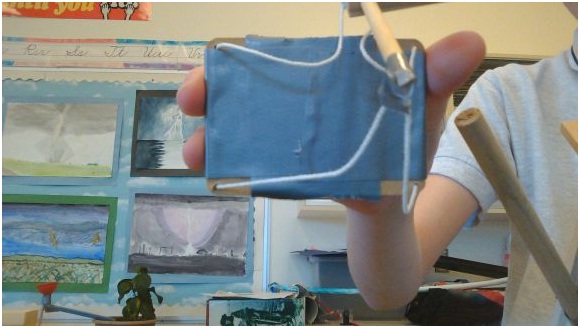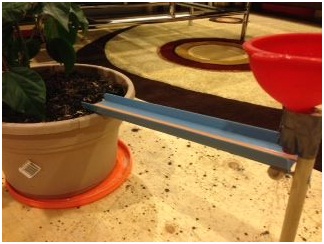





Published on Feb 13, 2025
The objective: Our project was to design a compound machine that could to work. We are using 2 simple machines to make our compound machine, the pulley and the inclined plane. Our machine's purpose is to water plants. Our plan is to lower (using a pulley) an ice cube into a funnel cup, where it will melt. The water from he melted ice cube will go into an inclined plane where it will slide into the plant.
We are making a plant watering machine. We are going to use an inclined plane to bring the water down into the plant and a hydraulic arm to bring the block of ice into a funnel cup. Our compound machine will be working against gravity. Gravity is the force that makes everything heavy. We included some information about gravity, plus some information about friction, screws and pulleys too!
I love going down inclined planes. They can be slides, water slides or steep roller coasters! An inclined plane is a flat supporting surface tilted at an angle, with one end higher than the other, used to help raise or lower something. Moving an object up an inclined plane requires less force than lifting it straight up. Inclined planes provide a mechanical advantage. Inclined planes are very important in the life of many people.
Pulleys are also very important. A pulley is a wheel on an axle that is made to support movement. Pulleys are used in a variety of ways to lift loads, apply forces, and to transmit power. Heron of Alexandria identified the pulley as one of six simple machines used to lift weights. Pulleys are assembled as part of belt and chain drives in order to transmit power from one rotating shaft to another. Without pulleys it would be very hard to lift and lower things
Screws are very important simple machines. A screw is a mechanism that adapts rotational motion to a linear force. The most common form consists of a cylindrical shaft with helical grooves or ridges called threads around the outside. The screw does work when it rotates in a circle and moves bolts or other objects clamped on to the metal surrounding the rod. As the screw shaft rotates, the nut moves linearly along the shaft. This is a type called a lead screw. A screw conveyor uses a rotating helical screw blade to move bulk materials.
Friction is a force that acts to stop the movement of two touching objects Two kinds of friction are static and kinetic. Static friction is when the friction is strong enough to stop movement between two objects. Kinetic friction is when the frictional force is not strong enough to stop all motion. Friction can be thought to be caused by bumps on two touching surfaces called asperities. Even the smoothest materials have these asperities. As these two rough surfaces move against each other they get stuck and prevent motion until the object stops. We had to use duct tape in our machine to reduce friction on a platform.
• Mini slide
• ice
• funnel cup
• large wood base
• two syringes
• two thin wood shafts
• small wood base
• duct tape
• small plastic tube
• two steel screws
• three miniature wood shafts
• two metal hooks
• two wood screws
• tall box
• large wood platform
• one thin large wood shaft
• two miniature circular wood rod
• two pieces of string
1. Take the small wooden base and glue one of the miniature wooden shafts on it
2. glue another a small space apart from the first
3. place a thin wood shaft at the top between the two rods
4. drill a hole between the 3 rods
5. put a miniature circular rod into the hole
6. drill another hole into the end of the wood shaft
7. take the 2 metal hooks and place one in between the 2 shafts and the other in the middle of the large shaft
8. take the small plastic tube and place it evenly between the 2 small shafts and in the hook
9. take the 2 syringes and put one at one end of the plastic tube and one at the other end
10. attach one of the syringes to the other metal hook
11. place the other circular rod in the hole at the end of the shaft
12. drill a hole through the tip of each side of the rod
13. put one string in between one of the holes and the other in the other hole
14. take the small wood base and drill a hole in each of the corners
15. attach the string to the wood base by putting the strings through the holes and knotting it
16. super glue the finished hydraulic arm to the tall box
17. place the other thin wood shaft onto the board 5 cm in front of the thin wood box
18. screw it in
19. tape the funnel cup to the top of the shaft
20. screw a miniature circular wood rod into the shaft under the funnel cup
21. take your inclined plane and place one end of it on the circular wood rod you just screwed in and place the other end on the soil in the plant, tilted downward
There were a lot of problems when we had thought we had finished our compound machine. Here's what we observed. We saw that the base that carries the load had a of friction so the ice on the board wasn't moving into the funnel cup. We had to reduce the amount of friction on the board. We did this by putting duct tape on the base.

We also saw that the funnel cup wasn’t at a perfect angle so whenever it dripped water it was missing the inclined plane and dropping onto the board. So we tilted the funnel cup 30 degrees to the right and taped it there so the water would drip onto the inclined plane.

Also, when we were testing our compound machine we noticed that the base for the hydraulic arm was not tilting forward so that the ice would fall into the funnel cup. We fixed this by taping a wood shaft to the side of the tall box, facing up. This caused the base to hit the top of the rod and tilt forward so the ice would fall.
I loved making our compound machine! It was really cool. Our machine is called the Auto-Waternator Version 1. The purpose of our machine is to water plants when you are away. We used 3 different simple machines to make up compound machine, the screw, the lever, and the inclined plane. We were trying to answer the following question: How can you water plants while you are away from your plant? We wanted to help the environment, even when you're not there! We are planning to use the Auto-Waternator Version 1 on Earth Day to make the planet greener!
Before we started making our compound machine we had to have a plan. Part of making this plan was to make a hypothesis. Here is our hypothesis: Our machine will water plants. We will have a pulley that lifts and lowers things. It will lower a piece of ice into a funnel cup. It will melt and fall into an inclined plane that will lead the water into the plant; Now, thinking about it, our hypothesis is pretty accurate. Even though our sketches are a lot different than how it actually turned out.
• Wikipedia contributors. “Archimedes’ screw”. Wikipedia, The Free Encyclopedia. <http://en.wikipedia.org/wiki/Archimedes'_screw>. 3/7/2014.
• Wikipedia contributors. “Friction”. Wikipedia, The Free Encyclopedia. <http://simple.wikipedia.org/wiki/Friction>. 3/11/2014.
• Wikipedia contributors. “Gravitation”. Wikipedia, The Free Encyclopedia. <http://en.wikipedia.org/wiki/Gravitation>. 3/7/2014.
• Wikipedia contributors. “Inclined plane”. Wikipedia, The Free Encyclopedia. <http://en.wikipedia.org/wiki/Inclined_plane>. 3/7/2014.
• Wikipedia contributors. “Pulley”. Wikipedia, The Free Encyclopedia. <http://simple.wikipedia.org/wiki/Pulley>. 3/12/2014.
• Wikipedia contributors. “Screw”. Wikipedia, The Free Encyclopedia. <http://en.wikipedia.org/wiki/Screw>. 3/8/2014.
• Wikipedia contributors. “Screw”. Wikipedia, The Free Encyclopedia. <http://simple.wikipedia.org/wiki/Screw>.